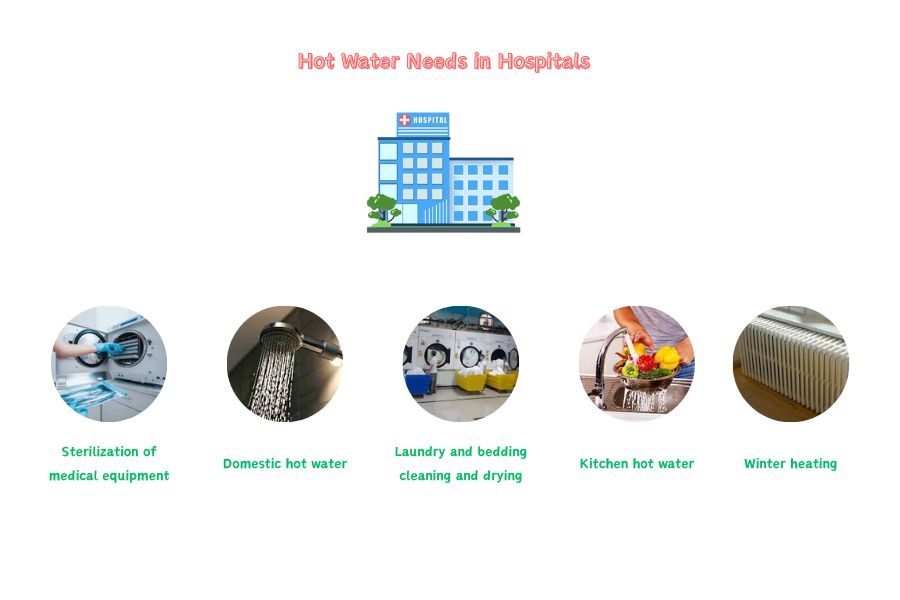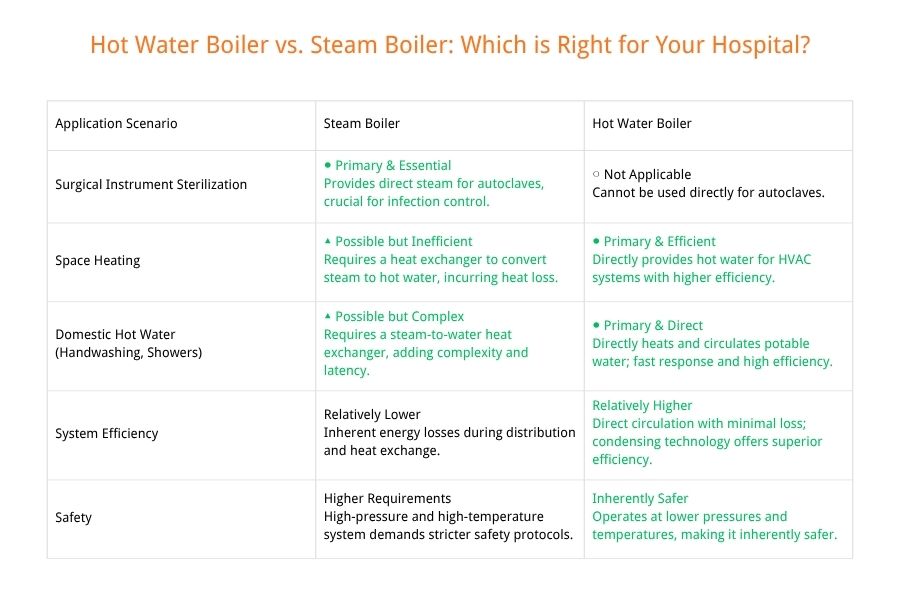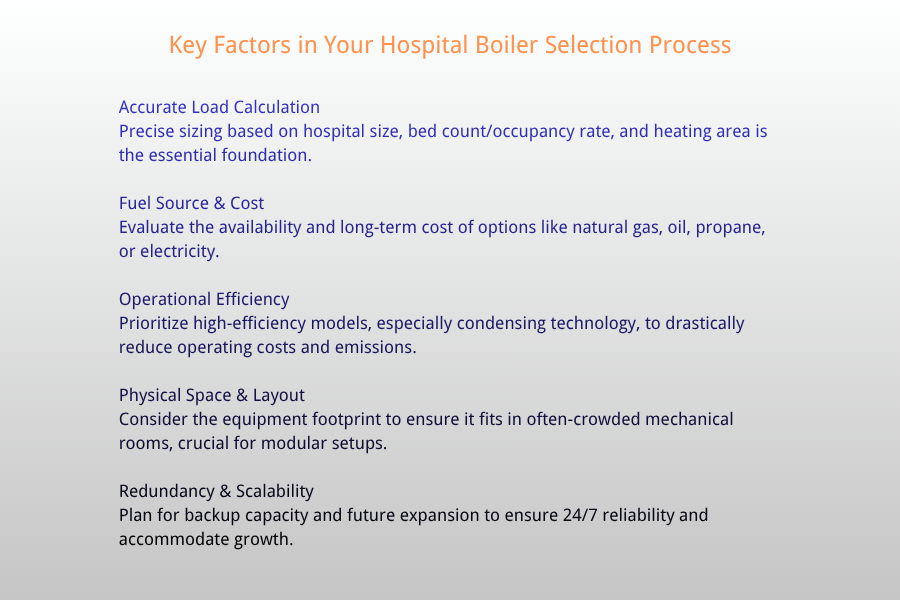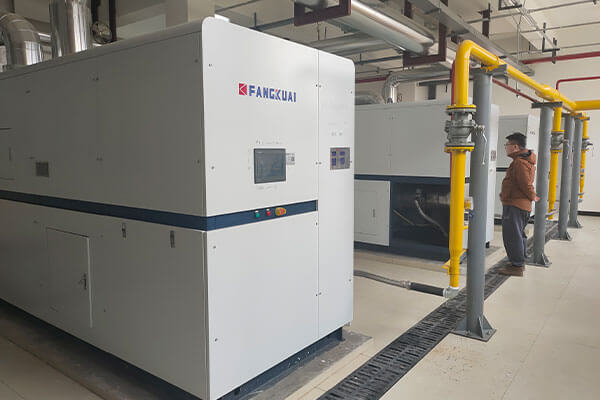Making the right choice for your hospital’s hot water boiler system isn’t just an engineering decision; it’s a commitment to patient safety, staff efficiency, and operational resilience. I understand that you’re facing a critical decision, one that will impact your facility for years to come. The pressure is on to get it right.
1. Understanding Your Hospital’s Unique Hot Water Demands
Before we even look at different models or brands, we need to start with you. What does your facility truly need? A hospital is a universe of hot water applications, each with its own critical requirements.
Think about your daily operations. You need a continuous and reliable supply of scalding-hot water for sterilization of surgical instruments. You need steady, comfortable water for countless patient showers and baths. Your laundry facility operates around the clock, washing linens and gowns. Your kitchen and cafeteria require hot water for sanitation and food preparation. Furthermore, you may need it for space heating in larger facilities.
The common thread here is reliability. A single boiler failure doesn’t just cause discomfort; it can lead to postponed surgeries, infection control breaches, and a significant disruption to patient care. When I advise on hospital hot water boiler systems, the first principle is always to understand this non-negotiable demand for unwavering reliability and volume.
2. Hot Water Boiler vs. Steam Boiler: Which is Right for Your Hospital?
This is a fundamental crossroads in your planning. While both generate heat, they serve different primary purposes.
A steam boiler is designed to produce—as the name suggests—steam. This is essential for tasks like high-temperature sterilization in autoclaves, humidification, and certain medical processes. However, using a steam boiler for general hot water requires additional equipment like heat exchangers, which adds complexity, cost, and potential points of failure.
A hot water boiler, on the other hand, heats water directly and circulates it throughout the building for all the applications we discussed: showers, laundry, kitchens, and even pre-heating for space heating systems. It generally operates at lower pressures and temperatures than a steam system, which can mean higher safety and energy efficiency.
So, which one do you choose? Often, the answer is both, but for different purposes. Many modern hospitals utilize a dedicated hospital hot water boiler for the bulk of their domestic needs and a smaller, specialized steam boiler solely for the sterilization department. This segregated approach enhances efficiency and reliability. For the purpose of this guide, we will focus primarily on the system that serves your general hot water load.
3. Key Factors in Your Hospital Boiler Selection Process
You now understand your needs and the basic type of system. But what separates a good choice from a great one? Here are the critical factors we must consider together in your hospital boiler selection process.
-
Hospital-Specific Load Calculations: This is the foundation. We cannot determine anything without first understanding your facility’s precise profile. This includes your hospital’s size (total square footage), patient capacity and occupancy rates, and critically, the total area requiring space heating. A 500-bed tertiary hospital has a vastly different demand profile than a 50-bed community clinic. Similarly, a high occupancy rate directly translates to a higher, more consistent hot water load from patient rooms and laundries.
-
Fuel Source and Availability: What is available and cost-effective for you? Natural gas is a common and efficient choice, but fuel oil, propane, or even electric boilers are options depending on your local utility rates and infrastructure.
-
Efficiency: Look for boilers with high Annual Fuel Utilization Efficiency (AFUE) ratings. A more efficient boiler directly reduces your operational costs and environmental footprint. Condensing boilers, for instance, can capture latent heat from exhaust gases, offering exceptional efficiency, especially when sized correctly for your typical load.
-
Footprint and Space: Hospital mechanical rooms are often crowded. The physical size of the boiler system and its required clearances are a practical concern you cannot ignore, especially when planning for a multi-boiler modular setup.
-
Redundancy and Scalability: This is so crucial for a hospital that it deserves its own section, which we will cover next.
4. How Do I Determine the Right Boiler Capacity?
Sizing a boiler is a precise engineering task, not a guessing game. An oversized boiler will “short-cycle”—turn on and off frequently—leading to wear and tear and reduced efficiency. An undersized boiler will struggle to meet demand, especially during peak hours (like the early morning when patient showers and laundry cycles coincide).
To determine the correct capacity, we calculate the peak hot water demand. This involves assessing:
-
The number of patient beds and bathrooms.
-
The capacity and schedule of the laundry facility.
-
The size and operating hours of the kitchen.
-
Any other significant hot water outlets.
Based on this data, we arrive at a total BTU/h (British Thermal Units per hour) requirement. This number is your guide. However, simply buying one giant boiler to meet this peak load is often the least efficient and most risky strategy. This brings us to the optimal solution.
5. The Optimal Solution for Hospital Boiler Selection
After working with numerous healthcare facilities, I have seen one strategy consistently deliver superior results: a modular boiler system with built-in redundancy.
Instead of installing one or two massive boilers, the optimal approach is to use multiple smaller, modular boilers that work together as a single, intelligent system. This is the gold standard for a reliable hospital hot water boiler setup.
Here’s why this solution is so effective:
-
Unmatched Redundancy: In a system with, for example, five boilers, if one unit needs maintenance or fails unexpectedly, the remaining four can automatically pick up the load. Patient care continues uninterrupted. You always have a built-in backup.
-
Peak Efficiency: During periods of low demand, such as at night, only one or two modules may need to run. They can operate at their full, most efficient capacity rather than a large boiler cycling on and off. As demand increases, the system sequentially fires up additional modules. This “stages” the energy input to perfectly match the load, maximizing efficiency and saving you money.
-
Scalability for Future Growth: If your hospital plans to add a new wing or increase services, you can simply add another module to the existing system. This is far more cost-effective than replacing a single, oversized boiler.
The recommendation is to have one or two boilers on standby, ready to be called upon during peak times or in case of a failure. This modular approach is, without a doubt, the most resilient and intelligent path for your hospital boiler selection.
Conclusion
Choosing the right hot water system for your hospital is a complex but critically important task. We’ve navigated through understanding your unique demands, compared boiler types, and outlined the key selection factors. Remember, the goal is not just to heat water, but to ensure a foundation of safety, efficiency, and resilience for your entire operation.
The most forward-thinking solution is clear: a modular hospital hot water boiler system. It provides the redundancy you need for peace of mind, the efficiency you require for cost control, and the flexibility you must have for future growth.
I hope this guide has been helpful. Your next step is to partner with a qualified engineering team to perform a detailed load calculation and design a system tailored precisely to your facility’s blueprint.
Frequently Asked Questions (FAQ)
Q1: What is the typical lifespan of a hospital hot water boiler?
With proper maintenance and water treatment, a well-selected commercial boiler can last 15 to 30 years. Modular systems often have an advantage as individual modules can be serviced or replaced without shutting down the entire system.
Q2: Can we integrate a new boiler system with our existing older ones?
Yes, in many cases, new modular boilers can be integrated with an existing system to improve overall efficiency and provide redundancy. This is a common strategy for phased upgrades.
Q3: What type of fuel is most cost-effective for a hospital boiler?
Natural gas is typically the most cost-effective and clean-burning option in regions where it is readily available. However, a detailed analysis of your local fuel prices and availability is essential.
Q4: Why is a steam boiler not recommended for general hot water needs?
Using a steam system for domestic hot water is inefficient. It requires a heat exchanger, which adds cost and complexity, and there are inherent heat losses in the steam distribution pipes and condensate return system. A dedicated hospital hot water boiler is more direct and efficient for this purpose.
Q5: How critical is water treatment for the boiler?
Extremely critical. Proper water treatment is not optional; it is essential for preventing scale buildup (which reduces efficiency), corrosion (which causes leaks and failures), and ensuring the system operates safely and reaches its intended lifespan.
Get your best price
Quickly compare 3 FREE quotes
- Engineer quick quote
- The overall delivery speed is fast
- Financial choice
- Low installation costs and cost savings
25 years+ of boiler R&D
More than 20 innovative technologies




